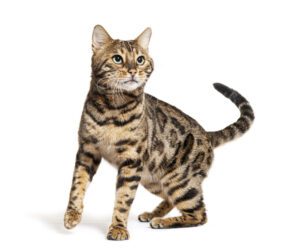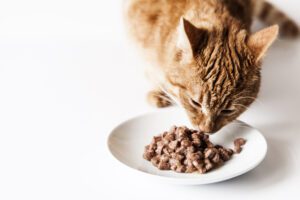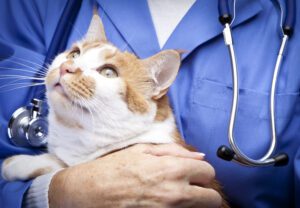
Our Veterinary Blog
Cat Hairballs: What to Do and How to Help
Hairballs are yucky tube-like structures of hair, food, and bile. Most cat parents have encountered the dreaded hairball at some point. So, what can you do to help your cat with hairballs?
There are a variety of ways to help your cat with their hairballs. You should start by grooming or brushing your cat regularly to eliminate the excess hair. You can also try hairball-specific remedies like special cat foods or other products made to control hairballs.
Most hairballs result from your cat over-grooming, and long-haired cats are particularly susceptible. Check out this article if you want to know more about cat hairballs and how to help your cat.

What is a Hairball?
A hairball is a collection of excess fur your cat swallows during grooming. Regurgitated hairballs tend to vary in size, however, they are typically about an inch long and can be as long as five inches and an inch thick. A hairball is usually shaped like a cigar or a thick tube with hair stuck in it. It looks like a solid piece.
The hairball gets its shape when hair is accumulated in the esophagus. When the hair reaches the stomach, it does not leave it, and what comes out looks like a tube. The color of the hairball usually matches the color of your cat’s fur. However, it will also mix with the color of their food, gastric secretions, and green bile.
What Causes Hairballs in Cats?
Cats groom themselves by licking their hair clean. Your cat’s tongue is rough enough to dislodge dirt, debris, and loose hair. Their way of grooming gives them their shiny, lustrous coat. When your cat ingests excess hair, they cannot digest it in their bodies. As a result, a hairball forms and is vomited out.
Long-haired cats are more susceptible to hairballs. Certain breeds, such as Ragdolls or Maine Coons tend to develop more hairballs. Hairballs also occur more frequently in the seasons of the year when cats shed their coats. Also, some cats will groom more often than others, which can cause more hairballs.
Are Hairballs a Concern?
It may be expected for a cat to vomit up a hairball every week or two. However, if your cat lacks energy and has no appetite for more than a day or so, or if they have repeatedly been vomiting for a period, you should consult your vet immediately. Some of the symptoms to watch out for include:
- Lack of energy and appetite
- Vomiting
- Abdominal pain
- Constipation or diarrhea
- Hacking, but not vomiting a hairball
Sometimes the cat cannot regurgitate the hairball, and it will pass through the stomach and into the intestine, precipitating a potentially life-threatening obstruction in the digestive tract. A hairball that cannot pass through the esophagus is also dangerous. These are two possible scenarios that require immediate veterinary care.
How Can I Help My Cat with Hairballs?
You want your cat to be safe and comfortable. There are a few ways you can help your cat with hairballs. You should always talk to your vet concerning their advice about hairball prevention and treatment. The following are some ways to help your cat with hairballs:
1) Brush Their Hair
Combing or brushing your cat’s hair on a regular basis will help to minimize hairballs. Frequent brushing will help remove dead hair, dander, and dirt. It is also a great way to connect with your cat, and helping them with grooming will decrease the need for your cat to lick themselves and get hair in their stomach constantly. Some good grooming tools for cats include:
- Aumuca Cat Dog Brush for Shedding
- Pet Grooming Glove Deshedding Brush Glove
- Groomer’s Best Small Combo Brush
- Detangling Pet Comb for Dogs & Cats
- Thunderpaws Best Professional DeShedding Tool
- Pet Dematting Comb 2-Sided Undercoat Rake
When grooming your cat, brush or comb gently in the direction in which the hair grows. Brush all over the body, including the chest and abdomen. Brush on one section at a time and remove loose hair and tangles. The more loose hair you can remove, the less chance there is of your feline companion overgrooming and developing hairballs.
2) Hairball Control Diet

A hairball control cat food has a specifically designed formula that helps eradicate hairballs. It typically has increased fiber to help your cat pass the hairball through their digestive tract. The average regular cat food has between one to two percent, but hairball control can have as much as eight percent fiber. The following include some hairball control foods:
- Blue Buffalo Indoor Hairball Control
- Science Diet Dry Cat Food Hairball Control
- Science Diet Dry Urinary & Hairball Control
- Purina ONE Natural Hairball Control Dry Cat Food
- Purina Pro Plan Hairball Control
- Royal Canin Dry Hairball Care Cat Food
Science Diet Urinary & Hairball Control is a great choice to protect both the health of the urinary tract and the gastrointestinal tract.
Sometimes other ingredients are added to this food, such as taurine for the heart and eyes. Hairball management cat food is often low in fat and high in fiber, however, you should remember that cats are carnivores, and if your cat consumes too much fiber, they may not get enough protein, which is vital to any cat’s health.
3) Hairball Control Treats
A cat’s routine would not be complete without their special treat time. In addition to hairball control food, you could also give hairball control treats to your cat:
- Greenies Feline SMARTBITES Treats
- Hartz Hairball Remedy Chicken Flavored Soft Chews
- Natural Hairball Control Chews for Cats
- Zesty Paws Hairball Bites for Cats
Many of these treats have omega-three, omega-six, or both to help coat health. Cats love their treats, but giving them sparingly is best to avoid weight gain or obesity.
4) Hairball Control Gel
When it comes to hairball control, you have choices. Lubricated gels contain various substances that can help hairballs come through the gastrointestinal tract. However, you must be careful when giving your cat these substances, as too much can trigger diarrhea. The following include hairball control gels you can give your cat:
- Hartz Hairball Remedy Plus Salmon Flavored Paste
- Nutri -Vet Cat Hairball Support Paw Gel
- Tomlyn Laxatone Maple Flavored Hairball Remedy
- Sentry Hairball Relief for Cats
Many of these hairball control gels help prevent future formations of hairballs. They usually come flavored in your cat’s favorite meat to coerce and appeal to them!
5) Shampoo and Wet Wipes
There are special shampoos and wet wipes which may be able to help your cat to control shedding. You can wipe them down every day with a damp wipe will help remove dander from your cat’s top coat. They can give your fur baby a fast clean-up without a bath.
Hartz Groomer’s Best Hairball Control is a great hairball shampoo for cats. It washes away excess hair and makes brushing or grooming your cat easier. You should always be sure that any product you use is safe for your cat and does not cause skin issues.
Conclusion
Hairballs are quite unpleasant and no fun for cats or pet parents. Luckily, there are numerous products out there that are geared toward helping your cat to limit or prevent hairballs.
If you have any other questions regarding your cat and hairballs, Plant City Animal Hospital in Plant City, FL is here to help. Reach out to us at (813) 752-3073 or visit us online!
Are you looking for a veterinary career? Our team at Ascend Vets is hiring! Visit our careers page to learn more about veterinary career openings.
Recent Posts
About Us
Family is family, whether it has two legs or four. At Plant City Animal Hospital, we've spent the last 40 years healing and caring for your pets. As a family-operated practice, we know that family is about more than simply being related. Animals give us the ability to develop strong bonds and feel great compassion for a fellow living creature.

